

Picture 61. Differentiation. Teaching Dropboxes. Imagine having a subject folder filled with handy resources, so you don’t have to reinvent the wheel?
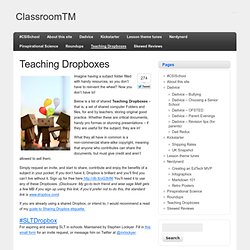
Now you don’t have to! Below is a list of shared Teaching Dropboxes – that is, a set of shared computer Folders and files, for and by teachers, storing original good practice. Whether these are critical documents, handy pro formas or stunning presentations – if they are useful for the subject, they are in! What they all have in common is a non-commercial share-alike copyright, meaning that anyone who contributes can share the documents, but must give credit and aren’t allowed to sell them. Simply request an invite, and start to share, contribute and enjoy the benefits of a subject in your pocket.
If you are already using a shared Dropbox, or intend to, I would recommend a read of my guide to Sharing Dropbox etiquette. #SLTDropbox For aspiring and existing SLT in schools. #ICTDropbox For ICT Teachers in Primary or Secondary Schools. #DLDropbox #sciDropbox For Science Teachers. How do I know how good my teachers are? At the heart of the discourse about effective schooling is the well-evidenced view that teacher quality plays a massive role in determining student outcomes.
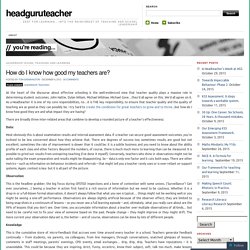
Getting the best out of classroom discussions. A problem shared is a problem halved, goes the old saying.
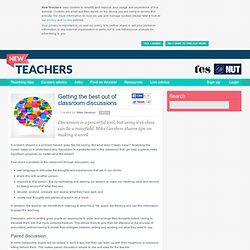
But what does it really mean? Analysing the maxim helps us to understand why discussion is a powerful tool in the classroom that can help pupils to make significant progress, no matter what the subject. If we share a problem in the classroom through discussion, we: How to move your lessons from good to outstanding. Where would I be without Twitter?

I have decided to elaborate on this AfL strategy, following this tweet from my @TeacherToolkit account on #ukedchat 3.11.11. My tweet said "#ukedchat Missed out tonight, look forward to reading ideas. AfL: Tight but loose…. Over the last few weeks there have been some very thought provoking posts on AfL on various teacher blogs.
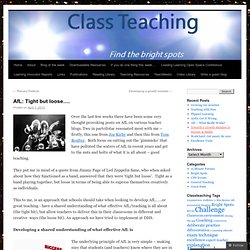
Two in partcilular resonated most with me – firstly, this one from Joe Kirby and then this from Tom Boulter. 8 Lessons Learned on Differentiating Instruction. My differentiation journey began in 2004 when my principal asked me to attend a weeklong summer conference on differentiated instruction.

I was eager to please my principal so I quickly accepted her offer. I was also extremely curious about how I, one person, could possibly address the individual needs of 100 students. By the end of the conference, I was totally overwhelmed with information: flexible grouping, assessment, inventories, tiered lessons, Carol Ann Tomlinson. My real work, though, didn't begin until after the conference, when I was expected to start using the training I'd received. I was expected to create four differentiated lessons that school year. Throughout that year, I utilized a variety of management pointers for a differentiated classroom that had been presented during the conference. Lesson 1. Differentiating Instruction: Meeting Students Where They Are, Teaching Today. The 5 Minute Lesson Plan. POP goes the planning! Some time in the summer of 2012 Michael Wilshaw gave a speech to the RSA about ‘good teachers’ (see here).
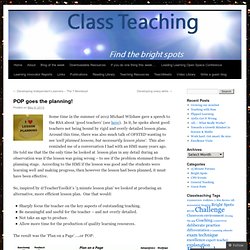
In it, he spoke about good teachers not being bound by rigid and overly detailed lesson plans. Around this time, there was also much talk of OFSTED wanting to see ‘well planned lessons, but necessarily lesson plans’. This also reminded me of a conversation I had with an HMI many years ago. He told me that the the only time he looked at lesson plan in any detail during an observation was if the lesson was going wrong – to see if the problem stemmed from the planning stage. According to the HMI if the lesson was good and the students were learning well and making progress, then however the lesson had been planned, it must have been effective.
So, inspired by @TeacherToolkit’s ’5 minute lesson plan’ we looked at producing an alternative, more efficient lesson plan. The result was the ‘Plan on a Page’…..or POP: Flexibility and creativity is a key feature of great teaching. 5 Minute Lesson Evaluation. Unlocking the Power of Progress. Great Lessons.
Questioning – Top Ten Strategies. “Learn from yesterday, live for today, hope for tomorrow.

The important thing is to not stop questioning.” – Albert Einstein Questioning is the very cornerstone of philosophy and education, ever since Socrates ( in our Western tradition) decided to annoy pretty much everyone by critiquing and harrying people with questions – it has been central to our development of thinking and our capacity to learn. Taking the ‘temperature of learning’ in lessons: a few tried and tested strategies. ‘Progress’ appears to be the buzz word in schools at the moment, especially during lesson observations.
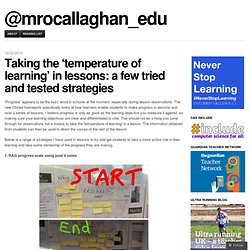
The new Ofsted framework specifically looks at how teachers enable students to make progress in lessons and over a series of lessons. I believe progress is only as good as the learning objective you measure it against, so making sure your learning objectives are clear and differentiated is vital. This should not be a hoop you jump through for observations but a means to take the ‘temperature of learning’ in a lesson. The information obtained from students can then be used to direct the course of the rest of the lesson. Outstanding lessons tick list. 2012-06-25_10-18-47.